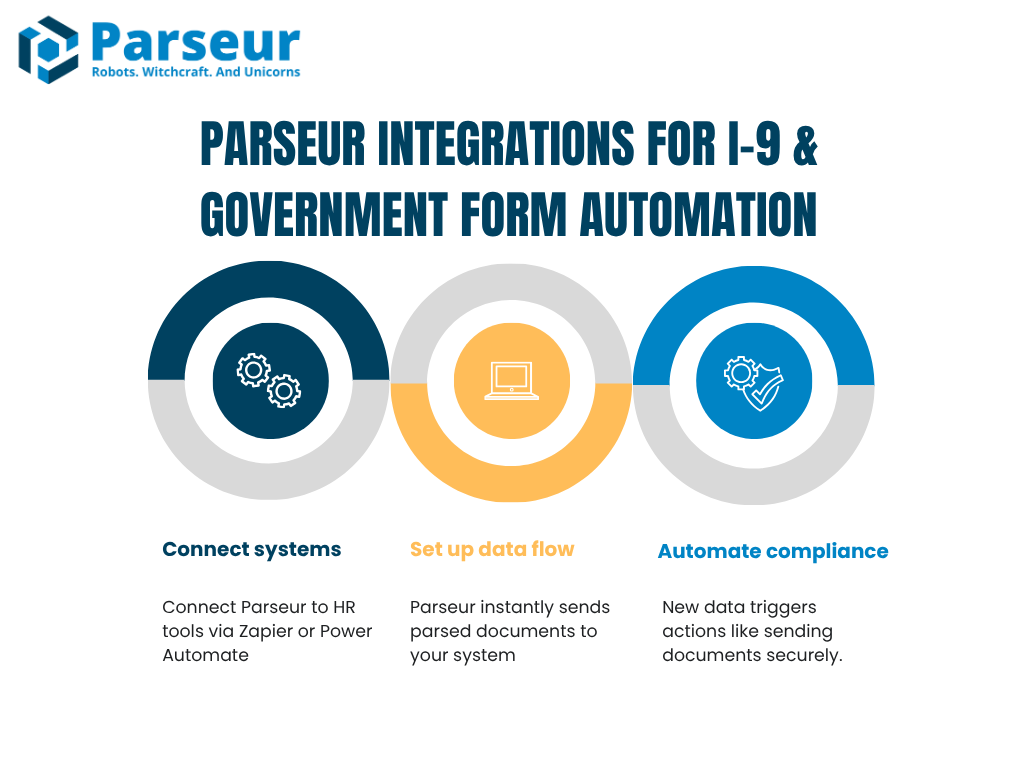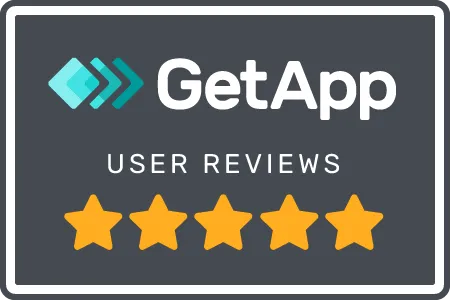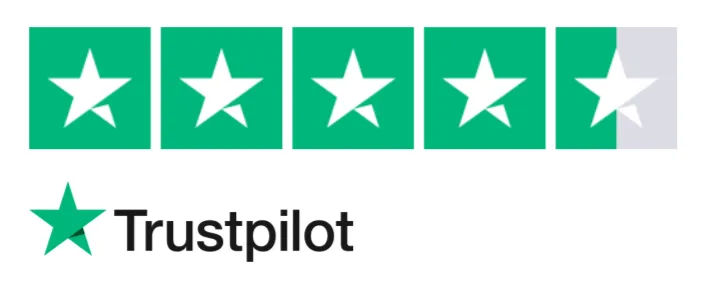Key Takeaways
- Manual processing of I-9s and government forms is time-consuming and prone to errors, creating compliance risks for HR teams.
- Parseur uses OCR and AI to accurately extract structured data from scanned or digital forms like I-9s, W-4s, and W-9s.
- The platform outputs clean data formats and integrates seamlessly with HR tools like BambooHR, Google Sheets, and Airtable.
- By automating document parsing, organizations save time, reduce labor costs, and maintain a secure, audit-ready onboarding process.
Government forms like the I-9, W-4, and W-9 are non-negotiable and some of the most tedious parts of employee onboarding. HR, compliance, and legal teams often spend hours manually copying information from PDFs or scanned paper documents into HRIS systems, spreadsheets, or cloud storage. This is not just inefficient; it opens the door to delays, compliance risks, and costly errors.
Take the I-9 form as an example. Employers must ensure every field is completed correctly, signed, and submitted on time. Even a single typo in a Social Security number or a missed expiration date can trigger audit flags or penalties.
According to SHRM, paperwork violations on Form I-9 can result in fines ranging from $234 to $2,332 per incident, while knowingly hiring unauthorized workers can cost between $583 and $4,667 for first-time offenses.
That is why modern HR teams are turning to tools like Parseur. Parseur automates the extraction of key data from scanned or digital government forms and transforms it into structured, usable information with no manual entry or technical setup required.
In this guide, we will walk through how government form parsing works, where the risks are in manual processing, and how Parseur makes it faster, more accurate, and scalable.
What Is I-9 And Government Form Parsing?
I-9 and government form parsing refers to the use of AI and OCR technologies to automatically extract structured data fields from official documents like I-9s, W-4s, and visa forms, converting them into digital data ready for review, storage, or integration.
Government form parsing goes beyond simply scanning documents into images. Scanning creates a flat, static version of a document, useful for record-keeping but not for automation. Parsing, on the other hand, turns that document into structured, searchable, and actionable data. This enables organizations to feed information directly into payroll systems, onboarding tools, and compliance workflows without manual data entry.
By 2026, up to 80% of companies are expected to adopt automated document processing, underscoring its growing importance, as reported by Formtek.
Government forms come in a variety of types, each with a specific function:
- I-9: Used to verify an employee’s employment eligibility in the U.S.
- W-4/W-9: Determine tax withholding or collect contractor information
- I-94/Visa documents: Record immigration status and travel history
- SSN requests and DS-11: Apply for Social Security numbers and U.S. passports
These forms are often submitted as PDFs, scans, or photos, and parsing must handle varied layouts, handwritten text, and sometimes poor image quality. Intelligent form parsers use a mix of OCR and AI to reliably extract the data fields that matter, so HR, legal, and operations teams can stay compliant without drowning in paperwork.
Manual Processing Risks & Challenges
Manual processing is still the norm for many HR and compliance teams handling I-9 and other government forms, but it comes with many risks. Flair HR reported that nearly 40% of the onboarding journey consists solely of paperwork tasks, significantly slowing down the process and increasing the risk of data errors.
Without automation, these teams must manage a high volume of sensitive documents while ensuring accuracy and compliance under tight deadlines.
HR and compliance teams often face challenges such as:
- Manual data entry into HRIS: Staff must read and type form fields line by line, increasing the chance of human error.
- Storing documents across multiple formats: Forms are often scattered in scanned PDFs, email attachments, printed copies, or e-signed files.
- Missing deadlines or incorrect information: Delays in submission or inaccurate Social Security or ID numbers can create onboarding setbacks.
Legal and audit risks include:
- Typo errors: Even a small mistake in names or numbers can lead to penalties or failed audits.
- Incomplete fields or missing signatures: These oversights can invalidate a form and cause legal complications.
- Poor tracking and organization: Without a consistent system, forms can go unnoticed or be lost entirely, especially in remote or hybrid setups.
These issues add up quickly and create a significant burden for HR teams. Without automation, organizations are left exposed to compliance gaps and avoidable inefficiencies.
How Parseur Automates I-9 And Government Form Parsing
Processing government forms like I-9s and W-4s can be time-consuming and error-prone, especially when dealing with scanned documents or photos submitted by remote hires. On average, Parseur customers save 189 hours of manual data entry per month, translating to $7,557 in labor cost savings. That makes Parseur 98% more cost-effective than manual entry, with a potential of over $90,000 saved annually, just by automating routine form processing.
Parseur simplifies this process by turning unstructured documents into clean, structured data for your HR systems. Here’s how it works:
1. Document collection
Send I-9s, W-4s, and other onboarding forms to your dedicated Parseur mailbox. Everything is routed to one central inbox, whether scanned copies, PDFs, or mobile uploads. You can even automate this process through an API connection or an email forwarding rule, ensuring all documents are collected and organized in one place for easy document processing.
2. AI-driven data extraction
Parseur’s powerful AI OCR and machine learning engine kick in as soon as the documents arrive. It automatically extracts key fields from each form. For I-9s, this includes employee name, Social Security Number (or redacted SSN), date of birth, citizenship status, and document expiration dates. For W-4s and other HR forms, it captures additional details like filing status, address, and date of signature.
3. Structured data output
Once the data is extracted, Parseur converts it into structured formats such as CSV, Excel, or JSON. This ensures consistent formatting across records, no more manual retyping or formatting headaches. Your HR team gets clean, usable data ready for reporting, compliance, or storage.
4. Seamless integration with HR tools
Finally, the structured data can be automatically sent to your HRIS (Human Resource Information System), ATS, payroll system, or secure cloud storage using integrations like Zapier, Make, Webhooks, or the Parseur API. This eliminates manual data entry and accelerates onboarding, helping your team stay audit-ready.
Whether you're processing forms for one new hire or a hundred, Parseur gives you a scalable, secure, and hands-free solution to government form parsing.
Use Cases: Who Needs This?
Parseur’s document parsing automation isn't just a tech upgrade; it's a transformative solution for teams who regularly handle I-9s, W-4s, and other employee onboarding forms. It transforms a traditionally manual, error-prone process into an enhanced, reliable workflow built for speed and compliance.
HR teams at fast-growing companies
As hiring scales up, so does the paperwork. Parseur helps HR departments eliminate onboarding backlogs by automating form intake and data extraction. Instead of manually reviewing each document, teams get structured data ready for payroll, benefits, and employee records, saving hours of administrative work.
According to HR Vision Event, 69% of HR professionals report that automating hiring workflows significantly reduces time spent on onboarding paperwork, with overall onboarding processes running 67% faster. One example is Santander's onboarding automation, which reduced onboarding time from 6 weeks to just 2 days, dramatically improving efficiency and saving valuable HR time during high-volume hiring periods, according to AI Multiple’s study.
Compliance and legal teams
Maintaining compliance with federal and state employment laws is non-negotiable, especially when dealing with I-9s and other government forms. Parseur helps ensure that all I-9 data is captured accurately and stored digitally, creating a reliable audit trail for internal reviews and government audits. This dramatically reduces the risk of penalties. This kind of automation isn’t just theoretical. A detailed overview by Lightico found that up to 76% of paper I-9 forms contain errors, and electronic systems with smart validation and real-time checks can substantially cut down on these mistakes.
In real-world applications, platforms like Imagility report 65% faster I-9 processing times and 100% compliance, showing how effective automation can be in reducing errors and protecting against compliance risks.
Staffing agencies and PEOs
For staffing firms and professional employer organizations (PEOs), managing high volumes of temporary workers and rapid onboarding cycles demands more than manual effort. Parseur makes it possible to process hundreds of forms each month with minimal lift, allowing teams to meet client demands quickly and accurately. The impact of automation is well-documented: according to FlowForma, 87% of organizations using onboarding automation report faster time to productivity for new hires, underscoring the value of scalable workflows.
In practice, if a large staffing agency dealing with hundreds of placements monthly were to rely on manual processing, it would face overwhelming administrative strain and a high risk of errors. That’s why many turn to automated solutions for forms like the I-9. As Rinku Thakkar noted, 68% of recruiting professionals believe investing in new recruiting technology is the most effective way to boost performance. The result? A 16% increase in new hire retention when onboarding tasks are automated.
Remote-first organizations
When employees are hired from anywhere, onboarding becomes a logistical challenge. Parseur supports scanned and mobile-uploaded documents, ensuring consistent data capture no matter how or where the forms are submitted. This helps remote-first teams create a seamless, standardized onboarding experience for every hire.
Compunnel noted that organizations with structured remote onboarding report 82% higher new-hire retention, emphasizing the value of automated and reliable systems in distributed work environments.
A great example is Remote.com, which supports globally distributed HR and payroll operations**. With over 1,700 employees worldwide,** they faced challenges onboarding quickly and accurately across multiple countries. They adopted Zapier-driven automation to connect systems like HRIS (Human Resource Information System), ATS, payroll platforms, and onboarding tools to improve their processes. As a result, they saw a 97% reduction in time spent on manual HR tasks, allowing their team to focus on more strategic, people-centered efforts while enhancing employee satisfaction, as reported by The Blueprint AI.
Integrations And Automation
Parseur is designed to fit seamlessly into your HR and compliance teams' tools. You can connect it through platforms like Zapier, Make, Microsoft Power Automate, or Integrately, linking Parseur’s data extraction directly into systems such as BambooHR, Google Sheets, or Airtable, making real-time workflows possible.

Here’s how this works in practice:
Connect systems
Use Zapier or Power Automate to hook Parseur into HR platforms like BambooHR, or to Google Sheets and Airtable for compliance tracking.
Set up data flow
Documents are parsed in Parseur and sent instantaneously to your chosen system, for employee onboarding, tax compliance, or audit logs.
Automate compliance workflows
New data triggers downstream actions, such as creating employee records, updating tax withholding information, or sending secure documents to legal systems.
These integrations require no technical setup, just a few simple steps in your chosen automation platform. Once set up, data flows happen instantly, maintaining accurate, up-to-date records without manual entry.
Parsing government forms like I-9s shouldn’t feel like a burden or expose your team to compliance risks. Whether processing a few forms a week or managing hundreds each month, Parseur helps enhance the process, accurately, securely, and without technical setup.
With Parseur, HR and compliance teams can:
- Extract key data from I-9s, W-4s, and other onboarding forms with 99.9% accuracy
- Reduce manual entry and eliminate copy-paste errors
- Maintain compliance with a digital audit trail and secure document handling
It’s the more innovative, faster way to handle employee documentation, no more chasing paperwork or second-guessing what was missed.
Frequently Asked Questions
Still have questions about how Parseur fits into your I-9 and onboarding workflow? We’ve answered the most common ones below to help you get started with confidence. Whether you're scaling your HR processes or tightening compliance, these FAQs have you covered.
-
Can Parseur extract data from scanned or signed I-9s?
-
Parseur uses AI Optical Character Recognition (OCR) to convert scanned or signed I-9s into machine-readable formats. It then accurately extracts key fields like full names, Social Security Numbers, expiration dates, and other required information for compliance tracking.
-
Is it secure to process sensitive documents like I-9s?
-
Yes, Parseur is built with data security in mind. It’s GDPR-compliant, encrypts documents during transfer and storage, and allows teams to set user-based access controls. This ensures sensitive data stays protected at all times.
-
Can I parse other government forms like W-9 or visa documents?
-
Absolutely. Parseur handles various government forms, including W-4s, W-9s, I-94 arrival/departure records, and even DS-11 passport applications. As long as the format is structured or semi-structured, Parseur can reliably extract the data.
-
Can Parseur push I-9 data into my HRIS or Google Sheets?
-
Parseur integrates with platforms like Zapier, Make, and Power Automate, allowing you to send parsed data directly to your HRIS, Google Sheets, Airtable, or even internal databases. You can also use its API for more custom workflows.
Last updated on




